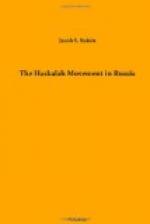Now, this Gaon of Vilna, or Hagra, was perhaps no less dissatisfied with prevailing conditions than the Besht, but his remedy for them was as different as the two personalities were unlike. He did not desire to abolish the Talmud, but rather to render it more attractive, by making its acquisition easier and putting its study on a scientific basis. Even in Lithuania, the citadel of the Talmud, the development of Talmudic learning had been hampered. In accordance with a Talmudic principle, mankind is continually degenerating, not only physically, but morally and mentally as well. It holds that if “the ancients were angels, we are mere men; if they were but men, we are asses.” This high regard for antiquity produced a belief in the infallibility of the rabbis on the part of the Mitnaggedim, similar to that in their zaddikim by the Hasidim. No scholar of a later generation dared disagree with the statement of a rabbi of a previous generation. But as authorities sometimes conflict with each other, the Talmudists regarded it their duty to reconcile them or to prove, in the words of the ancient sages, that “these as well as those are the words of the living God.” Similarly, the popes declared that, despite their contradictions, the Biblical translations of Sixtus V and Clement VIII were both correct.
It is true that Lithuanian Talmudists were not always the slaves of authority which they ultimately became. A study of the works of the early Slavonian rabbis, before and after Rabbi Polack, shows that they were free from unhealthy awe of their predecessors, and sometimes were audaciously independent. Neither Solomon Luria (Maharshal), Samuel Edels (Maharsha), or Meir Lublin (Maharam) refrained from criticising and amending whenever they deemed it necessary. But in the course of time the casuistic method, originally a mere pastime, became the approved method of study, and produced what is known as pilpul. Scholars wasted days and nights in heaping Ossa upon Pelion, in reconciling difficulties which no logic could harmonize. Here the Gaon found the first and most urgent need for reform. The Talmudists, he declared, were not infallible. Every one may interpret the Mishnah in accordance with reason, even if the interpretation be not in keeping with the traditional meaning as construed by the Amoraim.[16]
His views on religion were equally liberal. The same process of reasoning which, spun out to its logical conclusion, led to pilpul in the schools, produced, when turned into the channel of religion, the over-piety culminating in the Shulhan ’Aruk. This remarkable book, with the euphonious name The Ready Table, prescribed enough regulations to keep one busy from early morning till late at night. The Jews found themselves bound hand and foot by ceremonial trammels and weighted down by a burden of innumerable customs. The spirit of freedom that had animated Slavonian Judaism during the Middle Ages had fled.




